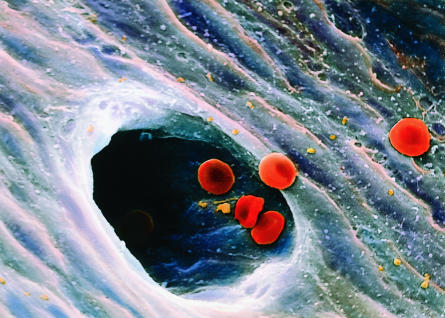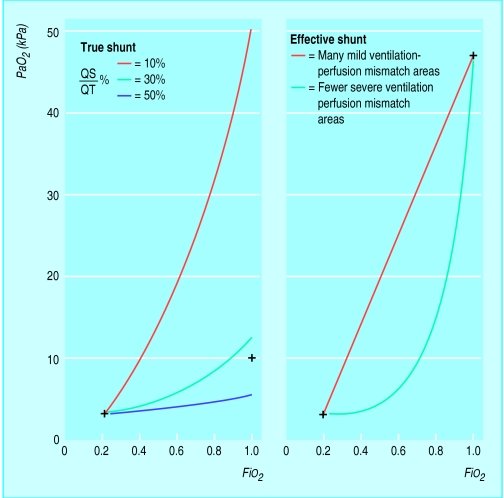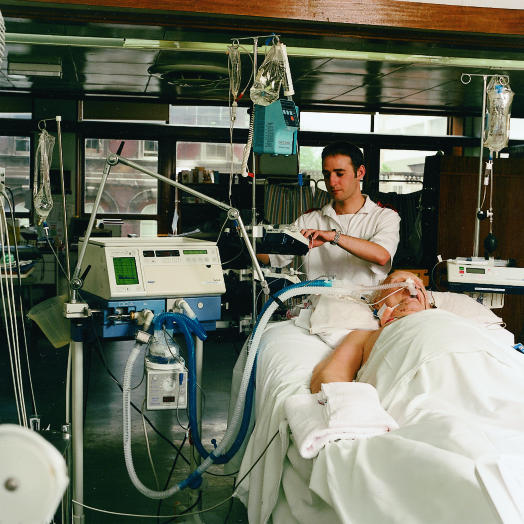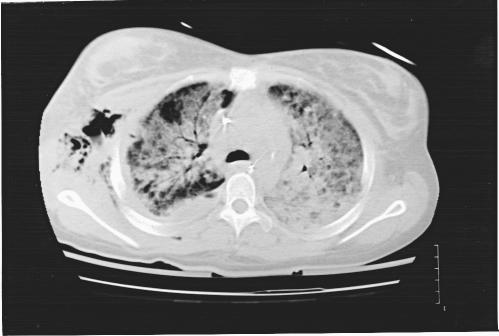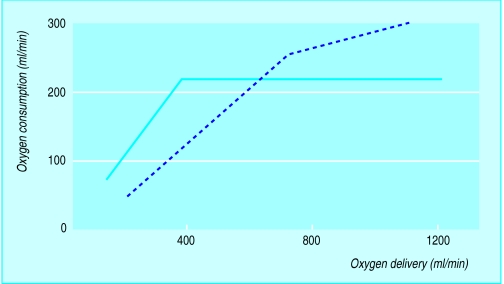Mammalian life and the bioenergetic processes that maintain cellular integrity depend on a continuous supply of oxygen to sustain aerobic metabolism. Reduced oxygen delivery and failure of cellular use of oxygen occur in various circumstances and if not recognised result in organ dysfunction and death. Prevention, early identification, and correction of tissue hypoxia are essential skills. An understanding of the key steps in oxygen transport within the body is essential to avoid tissue hypoxia.
Physiology of oxygen transport
Although oxygen is the substrate that cells use in the greatest quantity and on which aerobic metabolism and cell integrity depend, the tissues have no storage system for oxygen. They rely on a continuous supply at a rate that precisely matches changing metabolic requirements. If this supply fails, even for a few minutes, tissue hypoxaemia may develop resulting in anaerobic metabolism and production of lactate.
Key steps in oxygen cascade
Uptake in the lungs
Carrying capacity of blood
Global delivery from lungs to tissue
Regional distribution of oxygen delivery
Diffusion from capillary to cell
Cellular use of oxygen
Partial pressures of oxygen at sea level (101 kPa)
| Po2 (kPa) | |
| Dry air | 21.3 |
| Inspired air (humidified) | 20 |
| Alveolar air | 14.7 |
Oxygen transport from environmental air to the mitochondria of individual cells occurs as a series of steps. The heart, lungs, and circulation extract oxygen from the atmosphere and generate a flow of oxygenated blood to the tissues to maintain aerobic metabolism. The system must be energy efficient (avoiding unnecessary cardiorespiratory work), match oxygen distribution with metabolic demand, and allow efficient oxygen transport across the extravascular tissue matrix. At the tissue level, cells must extract oxygen from the extracellular environment and use it efficiently in cellular metabolic processes.
Oxygen uptake in the lungs
Arterial oxygen tension (Pao2) is determined by inspired oxygen concentration and barometric pressure, alveolar ventilation, diffusion of oxygen from alveoli to pulmonary capillaries, and distribution and matching of ventilation and perfusion.
Inspired oxygen concentration and barometric pressure
The percentage of oxygen in atmospheric air is constant at 21% and does not change with altitude. Atmospheric pressure is the sum of the partial pressures of the constituent gases, oxygen and nitrogen, and varies with the weather and altitude.
Effect of tidal volume on ventilation
If minute volume is 6 l/min, respiratory rate is 10 breaths/min, tidal volume 0.6 l, and dead space 0.15 l:
Va=10×0.6−0.15=4.5 l, which is adequate
If minute volume is 6 l/min, respiratory rate 30 breaths/min, tidal volume 0.2 l, and dead space 0.15 l:
Va=30×0.2−0.15=1.5 l, which is inadequate
Alveolar ventilation
Ventilation of the alveoli is essential if alveolar oxygen pressure (Pao2) is to be maintained and carbon dioxide removed. Alveolar ventilation (Va) depends on the rate of breathing and the tidal volume (Tv). A normal tidal volume of 600 ml results in alveolar ventilation of 450 ml, with 150 ml to overcome the physiological dead space of the tracheobronchial tree. At very low tidal volumes the dead space alone may be ventilated even though the minute volume (rate x tidal volume) is normal due to a high respiratory rate. Alveolar hypoventilation is reflected by a fall in alveolar and arterial Po2 with increasing Paco2.
Aims of treating alveolar hypoventilation in chronic obstructive pulmonary disease
Correct the cause of respiratory pump failure
Improve efficiency of ventilation
Reduce the work of breathing through bronchodilators or use of invasive or non-invasive ventilation
Diffusion from alveoli to pulmonary capillaries
The Pao2provides the driving pressure for diffusion into the pulmonary capillary blood and in normal conditions is the main determinant of the partial pressure of oxygen in arterial blood (Pao2). The Pao2-Pao2 (A-a) gradient describes the overall efficiency of oxygen uptake from alveolar gas to arterial blood in the lungs. It is normally less than 1 kPa but may exceed 60 kPa in severe respiratory failure.
The capillary blood is usually fully oxygenated before it has traversed one third of the distance of the alveolar-capillary interface. Inadequate oxygenation because of a shortened pulmonary capillary transit time occurs only with very high cardiac output or severe desaturation of mixed pulmonary arterial blood. Impaired diffusion of oxygen from alveolar gas to pulmonary capillary blood is uncommon. Arterial hypoxaemia in fibrotic lung disease is related more to ventilation-perfusion mismatching than to thickening of the alveolar wall.
Causes of arterial hypoxaemia
Alveolar hypoventilation
Respiratory depression from sedation or analgesia
-
Respiratory muscle weakness:
- Prolonged mechanical ventilation
- Catabolic effects of critical illness
- Muscle relaxants or steroids
- Phrenic nerve damage (cardiac surgery or trauma)
- Neuromuscular disorders (Guillain-Barré, etc)
Obstructive airways disease
Diffusion
Pulmonary oedema
Acute respiratory distress syndrome (particularly with fibrosis in later stages)
Ventilation-perfusion mismatch
Alveolar collapse
Acute respiratory distress syndrome
Pneumothorax
Obstructive airways disease
Drugs—pulmonary vasodilators
Distribution and matching of ventilation and perfusion
Efficient gas exchange requires matching of alveolar ventilation and perfusion. Inadequate ventilation of perfused alveoli or reduced perfusion of well ventilated alveoli impairs reoxygenation of pulmonary arterial blood and is termed ventilation-perfusion (V/Q) mismatch.
The net effect of abnormalities in the distribution of ventilation and perfusion is calculated as the venous admixture (Qs/Qt), which includes “true” shunt (mixed venous blood that completely bypasses the pulmonary capillary bed) and “effective” shunt due to ventilation-perfusion mismatch. Venous admixture is normally less than 5% of the cardiac output and is reflected by a low A-a gradient. A “true shunt” above 30% of total pulmonary blood flow will greatly lower Pao2. In these circumstances increasing inspired Po2 will have little effect on Pao2. Similar reductions in Pao2 due to ventilation-perfusion mismatch respond to oxygen.
Management of arterial hypoxaemia
Appropriate management of arterial hypoxaemia due to failure of oxygen uptake in the lungs depends on the underlying cause.
Supplemental oxygen
The mechanism responsible for hypoxaemia (Pao2<8 kPa) in critically ill patients may not be obvious. Immediate supplemental oxygen is essential. Small increases in Pao2 may produce valuable increases in oxygen saturation and delivery to tissues because of the shape of the oxygen dissociation curve. The increasing hypercapnia and respiratory acidosis seen in critically ill patients is not caused by oxygen treatment but by progression of the underlying respiratory problem and the patient’s inability to sustain the work of breathing. Reduction of oxygen, in the mistaken belief that ventilatory drive will increase and Paco2 fall, will increase hypoxaemia and risks cardiorespiratory arrest. The only exception to this is certain patients with chronic obstructive pulmonary disease who require controlled oxygen to avoid carbon dioxide retention.
Physiotherapy
Alveolar collapse and hypoventilation may increase ventilation-perfusion mismatch and can be corrected by mobilisation, increased clearance of secretions, enhancing tidal breaths by sitting the patient up to improve diaphragmatic descent, and the use of ventilatory aids such as the incentive spirometer.
Non-invasive ventilation
Non-invasive techniques have been a considerable advance in the treatment of patients with respiratory pump failure or alveolar collapse. These techniques may prevent the need for invasive mechanical ventilation and allow earlier extubation of the ventilated patient.
Benefits and disadvantages of continuous positive airways pressure
Benefits
Recruitment of collapsed alveoli
Increase in end-expiratory lung volume
Reduced A-a gradient
Improved lung compliance
Reduced work of breathing
Disadvantages
High Fio2 can conceal severity of condition
Discourages coughing and clearance of secretions
Risk of aspiration
Discomfort
Continuous positive airways pressure is valuable for patients with low lung volumes (alveolar collapse, pulmonary oedema, pneumonia) but should be avoided in patients with bronchospasm and at risk of gas trapping. The simplest system involves a flow generator connected to a wall oxygen supply that entrains air to achieve a Fio2 of 0.3-1.0. The gas flow is connected to the patient via a face or nasal mask and to a valve that opens with a predetermined pressure in the range 2.5-10 cm H2O. Provided the gas flow exceeds the patient’s maximum inspiratory flow rate, the exit valve is held open and the selected pressure is obtained throughout the circuit and airway.
Non-invasive positive pressure ventilation is delivered by using a portable ventilator with inbuilt compressor that entrains room air to generate pressures greater than 20 cm H2O during inspiration. This increases tidal and minute volumes and reduces the patient’s respiratory workload. The technique is suitable for patients with respiratory pump failure and chronic obstructive pulmonary disease. A nasal mask is often used, but a chin strap may be required to prevent excessive flow through the mouth. The patient requires reassurance and careful matching of the timing and pressure of ventilation to their respiratory pattern.
Biphasic positive airways pressure combines the benefits of the two techniques above. It delivers two levels of pressure in phase with respiration. The higher pressure provides the inspiratory pressure support and the lower pressure is maintained during expiration, increasing functional residual capacity. It is indicated for patients who require both assistance with the work of breathing and improved ventilation-perfusion matching.
Mechanical ventilation
In over 60% of patients appropriately admitted to intensive care units non-invasive strategies will not achieve adequate Pao2 and formal mechanical ventilation is needed. By this stage impaired gas exchange will often be caused by both ventilation-perfusion mismatch and alveolar hypoventilation.
Mechanical ventilation eliminates the metabolic cost of breathing, which is normally less than 5% of the total oxygen consumption (Vo2) but may rise to 30% in critically ill patients. It allows the patient to be sedated, given analgesia, and if necessary paralysed, which further reduces Vo2.
The timing, pressure, and flow characteristics of the respiratory cycle may be controlled to recruit alveoli, minimise the ventilation-perfusion mismatch, and improve arterial oxygenation. The Fio2 should be less than 0.8 to avoid the collapse of low ventilation-perfusion lung units and to reduce the risk of oxygen toxicity and pulmonary fibrosis.
Specialised techniques to improve arterial oxygenation
When conventional strategies fail to achieve acceptable arterial oxygenation other recently introduced techniques may be tried:
Nitric oxide added to the inspired gas in low concentrations (1-20 parts per million) vasodilates the pulmonary vascular bed adjacent to ventilated alveoli, which improves ventilation-perfusion matching. It is rapidly scavenged by haemoglobin and therefore does not produce systemic vasodilation. Although arterial oxygenation may improve greatly, the response is unpredictable and rebound hypoxaemia may occur on withdrawal. The benefit is not clinically proved, and the potential risk of lung toxicity is not established.
Prone position—Hypoxaemia may occur in supine ventilated patients who develop severe dependent consolidation with a large shunt fraction. Turning the patient from supine to prone improves gas exchange in about half of patients through redistribution of ventilation. It can also improve drainage of secretions from previously dependent areas of lung. Response usually occurs within 15 minutes.
Extracorporeal membrane oxygenation is a final option in patients with unacceptable arterial hypoxaemia despite the use of other techniques. Venous blood is passed through a membrane oxygenator at up to 4 l/min and returned 100% saturated with oxygen and with 50% of carbon dioxide removed. This can provide 50% of the total oxygen requirement and allows Fio2, airways pressure, and tidal volume to be reduced, resting the lungs and reducing the risk of ventilator induced lung injury. Its benefit is proved for neonates but its value in adults is unclear.
Oxygen carrying capacity of the blood
Most oxygen is carried in the blood attached to haemoglobin with only a small amount (typically less than 2% if Pao2<14 kPa) dissolved in the plasma. Despite this, the optimum haemoglobin concentration in critically ill patients is 100-110 g/l, which represents the balance between maximising oxygen content and the adverse microcirculatory effects associated with the marked rise in viscosity that occurs at higher packed cell volumes.
Effect of increasing levels of supplemental oxygen and transfusion in an anaemic hypoxaemic patient showing importance of saturation and haemoglobin concentration
| Fio2 | Pao2 (kPa) | Sao2 (%) | Hb (g/l) | Dissolved O2 (ml/l) | Cao2 (ml/l) | Cao2 (% exchange) | |
| Air | 0.21 | 6 | 75 | 80 | 1.4 | 83 | — |
| 35% O2 | 0.35 | 9.5 | 93 | 80 | 2.2 | 103 | 24 |
| 60% O2 | 0.6 | 16.5 | 98 | 80 | 3.8 | 110 | 7 |
| Transfusion | 0.6 | 16.5 | 98 | 120 | 3.8 | 164 | 48 |
Cao2=(haemoglobin (Hb)×saturation (Sao2)×1.36)+(Pao2×0.023) ml/l, where 1.36 ml is the volume of oxygen carried by 1 g of 100% saturated haemoglobin and Pao2×0.023 is the oxygen dissolved in 100 ml of plasma.
Oxygen delivery from lungs to tissue
The major function of the central circulation is to transport oxygen from the lungs to the peripheral tissues at a rate that satisfies overall oxygen consumption. Failure of this component of the oxygen cascade to supply sufficient oxygen to meet the metabolic requirements of the tissues defines circulatory shock. Under normal resting conditions the total or “global” oxygen delivery (Do2) is more than adequate to meet the total tissue oxygen requirements (Vo2) for aerobic metabolism. Do2 is defined as the product of cardiac output (Qt) and oxygen content of blood (Cao2). Cao2 is derived from the saturation (Sao2), haemoglobin content (Hb), and a constant K (the coefficient for haemoglobin-oxygen binding capacity). Thus Do2 (ml/min)=Qt×Hb×Sao2×K.
Mechanisms causing failure of global oxygen transport
Reduction in cardiac output (for example, heart failure) results in “low flow” tissue hypoxia
Fall in haemoglobin concentration or failure of haemoglobin mediated oxygen binding or release (for example, haemoglobinopathy) produces “anaemic” tissue hypoxia
Failure of oxygen uptake by blood (for example, inadequate ventilation, ventilation-perfusion mismatching, low Fio2) results in “hypoxic” tissue hypoxia
The importance of oxygen delivery in the management of critically ill patients depends on its relation with oxygen consumption. The sum of the oxygen consumptions by the various organs is the global oxygen consumption (Vo2), which can be measured directly or derived from measures of cardiac output (Qt) and arterial and venous oxygen contents: Vo2=Qt×(Cao2−Cvo2).
The amount of oxygen consumed (Vo2) as a fraction of oxygen delivery (Do2) defines the oxygen extraction ratio (Vo2/Do2).
In a normal 70 kg adult undertaking normal daily activity Vo2 would be 250 ml/min with an oxygen extraction ratio of 25%. The oxygen not extracted by the tissues returns to the lungs and the mixed venous saturation (Svo2) measured in the pulmonary artery represents the pooled venous saturation from all organs. Svo2 will be influenced by changes in both Do2 and Vo2, but provided that regional perfusion and the mechanisms for cellular oxygen uptake are normal it will be >65% if the supply matches demand.
Oxygen saturation in blood draining from different organs varies widely (hepatic venous saturation is 30-40% and renal venous saturation about 80%) and reflects both oxygen delivery and metabolic demands of these tissues
As metabolic demand (Vo2) increases or supply (Do2) diminishes, the oxygen extraction ratio rises to maintain aerobic metabolism. However, once the maximum extraction ratio is reached (at 60-70% for most tissues) further increases in demand or falls in supply lead to hypoxia. In critically ill patients, however, the slope of maximum oxygen extraction ratio is less steep, reflecting the reduced extraction of oxygen by tissues, and does not plateau so that consumption remains supply dependent even at “supranormal” levels of oxygen delivery.
A large study of postoperative patients reported that increasing global oxygen delivery above normal levels increased oxygen consumption and improved survival. This demonstration of “supply dependence” led to the hypothesis that critically ill patients had covert oxygen debt that could be eliminated by increasing oxygen supply and spawned the era of “goal directed therapy.” Cardiac output was increased to achieve oxygen supply rates above 600 ml/min/m2 by aggressive volume loading and the use of vasodilating inotropes.
Although increasing the oxygen supply by volume replacement in relatively volume depleted postoperative patients is appropriate, recent European studies have shown that it may be detrimental in adequately resuscitated patients presenting with incipient or established multiorgan failure. Aggressive fluid loading may impair pulmonary gas exchange and reduce oxygen diffusion in tissues due to increased endothelial permeability and myocardial dysfunction in inflammatory and septic conditions in critically ill patients. The increase in mortality associated with the use of pulmonary artery catheters may reflect the adverse effects of their use in attempting to achieve supranormal levels of oxygen delivery.
Figure.
Red blood cells entering a capillary
Figure.
Oxygen transport from atmosphere to mitochondria. Values given in parenthesis are for a healthy 70 kg adult breathing air (Fio2 0.21) at standard barometric pressure
Figure.
Effect of true shunt (Qs/Qt) and effective shunt (ventilation-perfusion mismatch) on relation between arterial and inspired oxygen partial pressures
Figure.
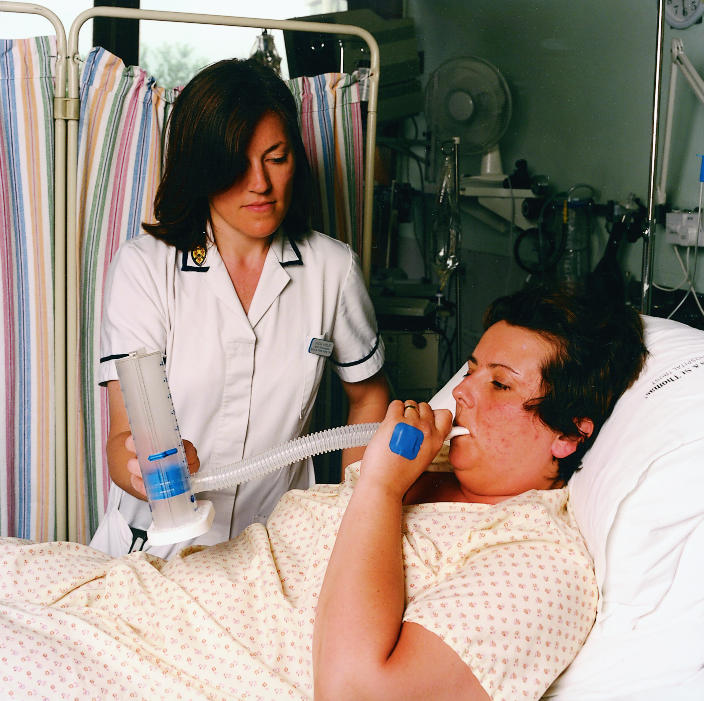
Incentive spirometer
Figure.
Patient receiving oxygen by continuous positive airways pressure
Figure.
Mechanical ventilation of critically ill patient in intensive care
Figure.
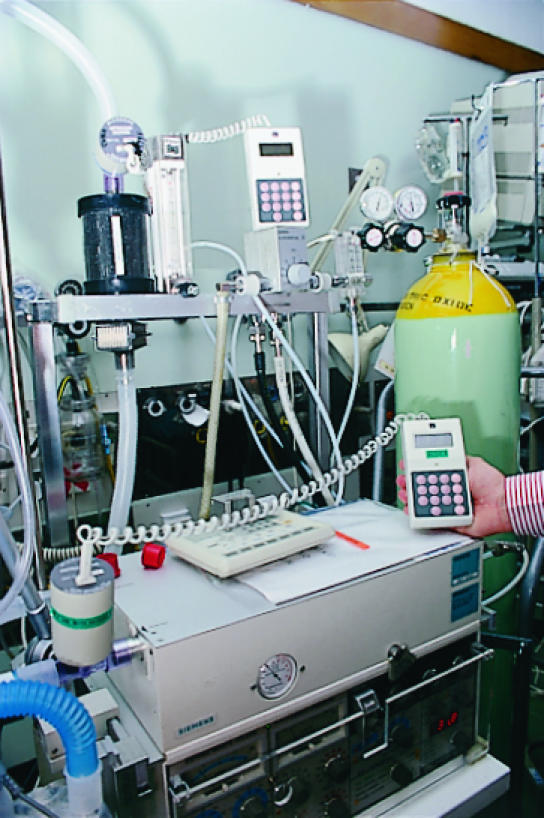
Addition of nitric oxide to inspired gas in a mechanical ventilator. Inspired concentration of nitric oxide and expired concentration of nitrogen dioxide must be measured
Figure.
Severe dependent consolidation in patient with acute respiratory distress syndrome which may improve with prone positioning
Figure.
Relation between oxygen delivery (Do2) and oxygen consumption (Vo2) in normal subject (solid line) and critically ill patient (dotted line)
Footnotes
D F Treacher is consultant physician in intensive care, Guy’s and St Thomas’s Hospital Trust, London
The ABC of Oxygen is edited by Richard M Leach, consultant physician, department of intensive care, and P John Rees, consultant physician, department of respiratory medicine, Guy’s and St Thomas’s Hospitals Trust, London.
The picture of red blood cells was obtained from Science Photo Library.



